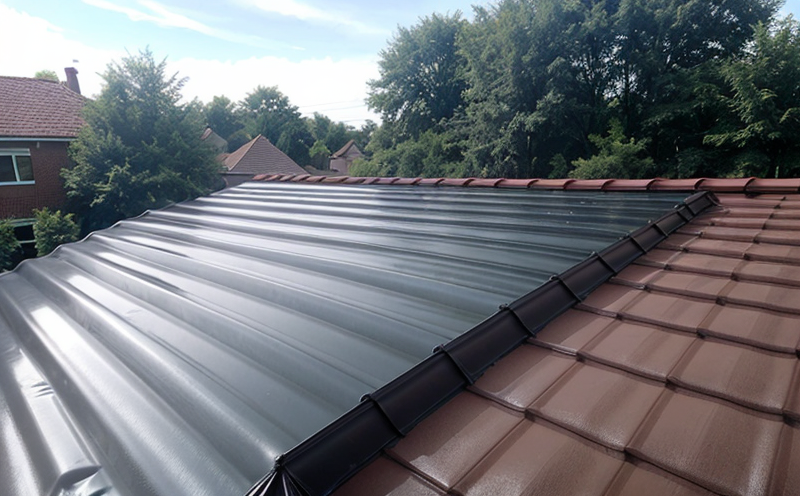ASTM E108 Fire Endurance Rating of Roof Coverings
The ASTM E108 standard is widely recognized as a critical benchmark for determining the fire resistance of roof coverings. This test evaluates how well a roof covering can withstand exposure to flames under controlled laboratory conditions, simulating real-world fire scenarios in commercial and residential buildings.
Roofing materials are exposed to high temperatures and intense heat during fires, which can lead to significant damage or even collapse of structures. ASTM E108 helps ensure that roofing products meet the necessary fire resistance criteria, enhancing safety for occupants and reducing property damage. The test is particularly important in regions prone to wildfires where fire-resistant materials play a crucial role.
The testing process involves placing roof coverings on a standardized specimen holder within a furnace. The temperature inside the furnace can reach up to 1202°F (650°C), and the specimens are exposed to flame for specific durations depending on their intended use. After exposure, the integrity of the roof covering is evaluated based on several criteria:
- Flame spread
- Smoke development
- Charring depth
- Loss of mass
- Structural integrity
The results are categorized into various flame classes, with Class A being the highest level of fire resistance. Achieving a higher class rating indicates better performance in resisting fire spread and smoke generation.
This test is crucial for both manufacturers and building owners as it ensures compliance with local and international building codes that mandate fire-resistant materials. For instance, many municipalities require roofing products to pass ASTM E108 testing to be used in specific areas or on structures of certain heights.
In addition to ensuring safety, passing this test can also offer significant competitive advantages for manufacturers. Products with higher flame ratings may command premium prices and open up new markets where stricter fire regulations are enforced. Moreover, compliance with ASTM E108 standards can reduce the risk of liability in case of fires involving buildings equipped with these materials.
The process of preparing specimens for ASTM E108 testing is meticulous. Specimens must be cut to standard dimensions and prepared according to precise specifications provided by ASTM. This includes ensuring that the edges are smooth, free from burrs or sharp corners, which could affect test results. Proper specimen preparation is critical as it ensures accurate and reproducible testing.
Instrumentation used in this testing typically includes furnaces capable of reaching high temperatures with precise control over temperature and exposure time. Advanced cameras and sensors may also be utilized to monitor the specimen's behavior during the test, providing detailed data on flame spread, charring depth, and other key parameters.
International Acceptance and Recognition
- Australia: The Australian Standard AS 1530.4:2016 for roof coverings explicitly references ASTM E108, indicating its wide acceptance in Australia.
- Canada: The National Building Code of Canada (NBC) mandates the use of materials that meet ASTM E108 standards for certain fire-resistant applications.
- United States: ASTM E108 is widely adopted across various states, including California and New York, which have stringent building codes requiring compliance with this standard.
The global acceptance of ASTM E108 extends beyond North America. Many countries in Europe and Asia also recognize the importance of fire-resistant roofing materials and often require products to pass ASTM E108 testing before being approved for use.
International recognition ensures that manufacturers can export their products across borders with confidence, knowing they meet the stringent requirements set by leading jurisdictions worldwide. This standardization not only promotes global trade but also helps establish consistent quality standards for fire-resistant roofing materials.
Environmental and Sustainability Contributions
- Energy Efficiency: Fire-resistant roofs can help reduce the risk of fires, which in turn minimizes the need for costly emergency responses. This contributes to lower energy consumption associated with firefighting efforts.
- Material Sustainability: Using fire-resistant materials ensures that buildings remain safe and intact during fires, potentially reducing the frequency of replacements and new construction needed after disasters.
Incorporating ASTM E108 into building codes and standards encourages the use of sustainable practices in roofing design and material selection. Fire-resistant roofs contribute to longer-lasting structures, which can lead to reduced waste generation and resource consumption over time. By promoting fire safety, these materials also support broader sustainability goals by minimizing environmental impacts associated with frequent rebuilding and replacement.
Additionally, the use of fire-resistant materials can promote the circular economy by reducing the need for new raw material extraction and processing when structures are rebuilt or decommissioned. This aligns with global efforts to reduce carbon footprints and promote sustainable development practices in the construction industry.
Competitive Advantage and Market Impact
The ASTM E108 fire endurance rating of roof coverings can provide a significant competitive edge for manufacturers. Achieving higher flame ratings not only enhances product safety but also opens up new market opportunities in regions with stringent building codes.
- Brand Reputation: Products that meet or exceed ASTM E108 standards are often perceived as safer and more reliable, enhancing the manufacturer's reputation among consumers and industry stakeholders.
- Premium Pricing: Higher flame ratings can justify premium pricing strategies, allowing manufacturers to command higher market prices for their products.
In markets where fire safety is a critical concern, such as densely populated urban areas or regions prone to wildfires, demand for ASTM E108 compliant materials is high. Manufacturers who meet these standards can capture a larger share of the market and potentially earn higher profits due to increased sales volume.
The test also helps in differentiating products within competitive landscapes. By offering fire-resistant roofing solutions that exceed basic flame ratings, manufacturers can position themselves as leaders in safety and innovation. This differentiation is particularly valuable in attracting high-end clients who are willing to pay a premium for superior quality and reliability.





